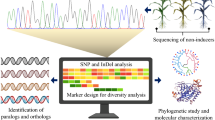Abstract
Diplosporous apomeiosis, formation of unreduced embryo sacs primarily of the Antennaria type, followed by parthenogenetic embryo development and pseudogamy (fertilization of the central cell) describe gametophytic apomixis within the Tripsacum agamic complex. Tripsacum dactyloides (Eastern gamagrass) is a close relative of domesticated maize and was chosen as a natural model system to investigate gene expression patterns associated with parthenogenesis. The genome size of diploid sexual and polyploid apomictic T. dactyloides was estimated by flow cytometry to be 7.37 pg (2C), 14.74 pg (4C) and 22.39 pg (6C), respectively. The diploid genome size is thus approximately 1.35× larger than that of maize. The apomeiotic-pseudogamous pathway of seed formation was demonstrated at a rate of 92% by the flow cytometric seed screen (FCSS) with single mature seeds in tetraploid accessions. This number includes twin embryos which were detected in 13% of the seeds analyzed. Fertilization of unreduced egg cells (BIII hybrids) was measured in 10% of apomictic seeds. Autonomous (fertilization-independent) embryo development and fertilization-dependent endosperm formation were confirmed by pollination of tetraploid T. dactyloides with a diploid transgenic maize line carrying an actin:: β -glucuronidase (GUS) reporter construct. GUS expression was detected after pollination in the developing endosperm, but not in the embryo. In similar intraspecific crossing experiments with maize, GUS expression was detected in both the embryo and endosperm. A protocol was established for microdissection of embryo sacs and early parthenogenetic embryos of T. dactyloides. Together, these techniques provide new tools for future studies aimed at comparing gene expression patterns between sexual maize and sexual or apomictic T. dactyloides
Similar content being viewed by others
Author information
Authors and Affiliations
Additional information
Revision accepted: 8 October 2001
Electronic Publication
Rights and permissions
About this article
Cite this article
Bantin, J., Matzk, F. & Dresselhaus, T. Tripsacum dactyloides (Poaceae): a natural model system to study parthenogenesis. Sex Plant Reprod 14, 219–226 (2001). https://doi.org/10.1007/s00497-001-0119-z
Received:
Published:
Issue Date:
DOI: https://doi.org/10.1007/s00497-001-0119-z




